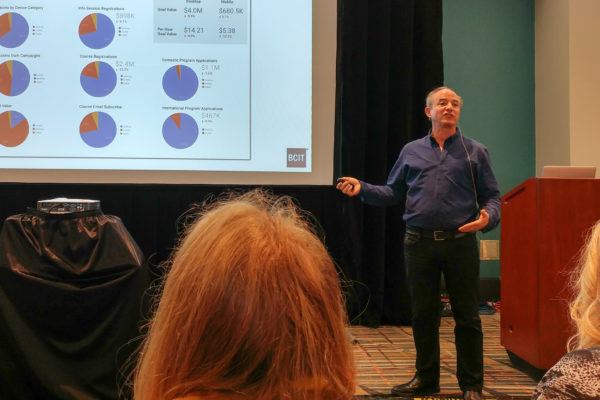A deeper understanding of Google Analytics can help organizations make better decisions about the features on their websites, said Alan Etkin at HighEdWeb17 on Tuesday.
Etkin, a senior analyst at the British Columbia Institute of Technology, dove into his methods during a session titled, “Au Contraire: Debunking Myths and Hippos with Google Analytics.”
Etkin shared that he began working with Google Analytics when it first debuted and has spent years learning how to leverage the data it provides. Specifically, for website design.
“I saw people taking hours to make uninformed choices,” Etkin said. “How many of you have rolled the dice when making decisions?”
Etkin pointed to the examples of large splash pages or call-to-action banners that decorate many homepages, including BCIT’s. A redesign had also replaced the search bar an icon of a magnifying glass.
Google Analytics soon debunked the myths that led to those decisions. Data showed few visitors clicked the call-to-action buttons—only .01 percent. And the removal of a search bar helped cause a 15 percent decrease in searches on the site.
“When I started at BCIT, there wasn’t a lot of focus on the website as an important part of the business,” Etkin said. “No one understood the value of user behavior on the website.”

So Etkin set out to change the way BCIT evaluated its traffic. Working with admissions, the registrar’s office, and other departments, he studied visitor behavior across the site. He ultimately assigned a predictive “Goal Value” to users. While different than revenue, it did help decision-makers quantify what visitors to the the BCIT website are worth.
The Goal Values Etkin created accounted for which types of device a visitor used (desktop, mobile, or tablet), whether or not they used in-site search, if they discovered the site via organic search, if they watched videos, and more.
He estimated the average visitor to BCIT’s website was worth $12, while those who used in-site search were worth $53.
“It showed how small decisions have a big financial impact,” Etkin said. He said BCIT has since brought back the search bar on its homepage, and he pointed to the importance of traffic from organic search to justify spending more on SEO.
Etkin shared a few key steps and takeaways for those who wanted to emulate BCIT’s use of data:
- Implement Google Analytics site-wide
- Track key conversions and create goals in Google Analytics
- Working with other departments, determine the value of each goal and add it to Google Analytics
- Consider using Google Data Studio, which gives Google Analytics users more sorting options
- Define and apply segmentations
Etkin stressed how developing a deeper understanding of website traffic and visitors’ behaviors can help teams make informed, strategic decisions. It can debunk common myths and justify choices to “HiPPOs” (highest paid person).
“It’s not about counting sessions and page views,” Etkin said. “It’s about knowing the value of user behavior.”

